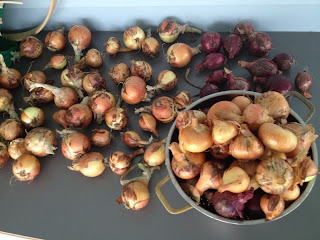Container Planting

When we moved in, we inherited several outdoor planters full of dirt. We added the dirt to the compost pile and tossed the containers aside. I gave several away, threw out the broken ones, and the kids used the remaining pair as outdoor chairs for most of this summer. Finally, though, I decided to put them to use for their intended purpose: In the center is a small plant of hardy chrysanthemums that I picked up for a few bucks at a local nursery . Those should give color throughout the fall, and I may try to tuck them into a cutting garden bed to overwinter and see if we can save them for next year. Around the edges of the container is some pennyroyal that I have been growing in pots this year. It was really tiny transplant when I bought it, but now it is big enough to divide into smaller pieces to set around the edge of the pot. Hopefully it will fill in and we'll have a lot more of the trailing stems cascading over the edge of the container. We now have two matching co...














